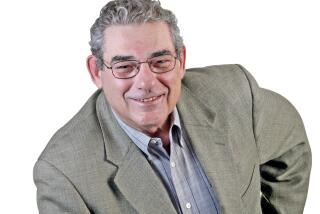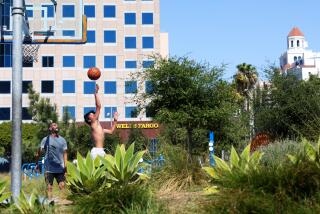Oran Asa Leaves a Newspaper Legacy
As a young boy growing up in the city of Orange, Oran Asa dreamed of becoming “the greatest sportswriter in the world.”
But when he graduated from Occidental College in 1935--at the height of the Great Depression--there were few openings for aspiring sportswriters.
With no other prospects, Asa accepted a $100-a-month job cleaning the offices of the Highland Park News-Herald. He didn’t intend to stay long; just until the economy improved and he could find another job.
But the temporary job as an office boy turned into a lifetime passion. Asa rose through the ranks of the newspaper, and became the publisher-owner in 1957.
Fifty-six years after he took that job, Asa, age 80, is just now leaving.
Troubled with deteriorating health, he has sold Northeast Newspapers--which eventually expanded to a group of eight papers--to Southern California Community Newspapers, a chain of 24 semiweeklies and weeklies in Southeast Los Angeles County and Orange County.
The sale price has not been disclosed.
“It’s the end of an era,” said Larry Hatler, who serves on the board of directors of the Highland Park Chamber of Commerce. “He was fantastic in his knowledge of this area, in his dedication to the community. Oran Asa was one of the last of those longtime pieces of the original Highland Park.”
Kathleen Aberman, president of the Eagle Rock Assn., agreed.
“He was a pillar of the community. I don’t think you could be any more plugged into a community than he was,” she said.
As the owner and publisher, Asa used his eight newspapers as forums for news that was too small or too localized to be covered in bigger papers. He ran stories about social service club meetings, public hearings, weddings and anniversaries.
“Our mission is to print community news, the news that can’t get on television and can’t get in the dailies. That’s what we live for,” said Roger Swanson, who has worked at the papers for 32 years and is now the editor.
But Asa also used his papers as political tools: to defend the best interests of the community as he defined them.
Although the papers never wielded as much clout as more powerful daily newspapers, they raised a persistent voice in debates over community issues.
In recent years, though, the newspapers have had trouble keeping up with the changing community demographics. The staff has fallen from a high of about 10 reporters and editors to six. Only one reporter speaks Spanish, although 60% of the residents within the papers’ circulation are Spanish speakers.
Asa was also frustrated by the papers’ inability to make inroads into the growing Chinese community in Highland Park, and Eagle Rock’s burgeoning Filipino population.
But with such a small staff, Swanson said, “we’re not able to cover any community adequately. We’re stretched pretty thin.”
The papers--which averaged 44 to 48 pages in the ‘60s and ‘70s--have been reduced by declining advertising revenue to about eight or 12 pages, Swanson said. And paid and unpaid subscriptions have not increased much since 25 years ago, when they peaked at 90,000, Asa said.
According to his own account, Asa came to the Highland Park News-Herald in 1933, while a history and political science student at Occidental. Seeking a part-time job to help finance his education, he landed in the paper’s print shop and worked setting type for 20 hours a week.
After his graduation, he was hired as a copy clerk to clean the office and do odd jobs. After three years, he was sent to display advertising, and a year later, was promoted to reporter.
Asa immediately found himself in the midst of one of the biggest local stories of his time--the battle over the development of the Pasadena Freeway. While following its numerous twists and convolutions over a period of several years, Asa began feeling a strong tie to the community.
The story derived from a fee levied by Los Angeles city officials on Highland Park property owners, to buy the Arroyo Seco riverbed and preserve it as a park.
But in 1936, six years after the land was acquired, city officials began proceedings to turn it over to the state for a freeway between Pasadena and downtown Los Angeles.
Highland Park residents were furious. They mounted numerous legal challenges, and lobbied legislators for repayment.
Asa covered numerous public meetings and protests, and met with people who he said lost their homes because they could not pay the fee.
The campaign for reparations was unsuccessful.
But afterward Asa realized that he felt he was a part of the little community that he believed had been so wronged by greater powers. He never again thought of leaving, and decided to dedicate his career to serving the area.
“I got very upset about it,” he said. “It was kind of discouraging. They were always downgrading the community.”
In 1946, the publisher of the Highland Park News-Herald, Oliver Jaynes, sold it, and moved to Palm Springs.
Asa felt the new management was not responsive to the community, and after a few weeks, he left the paper in protest and struck out to found his own.
In the beginning, Asa’s Highland Park Journal had no offices, no advertising and no staff. He wrote all the articles for the first editions, and typed many of them in his car.
Later, a friend with an insurance business offered to give him a spare office and one day, a man walked in and offered to sell advertising for the new publication.
From those modest beginnings, Asa’s upstart Highland Park Journal grew to a staff of 10 and became stiff competition for the older newspaper. Eleven years later, the News-Herald’s owner asked Asa to buy him out, and the two papers merged, becoming the News-Herald & Journal.
Asa subsequently acquired the the Lincoln Heights Bulletin-News, the Mt. Washington Star Review, the Eastside Journal, the El Sereno Star, the Eagle Rock Sentinel and the Belvedere Citizen. He also founded the Pasadena Journal.
Asa took a hands-on role in managing the newspapers and his philosophy permeated his printed products, friends and colleagues say. He never shied away from political controversy, and he never feared taking an unpopular position.
In the 1950s, he editorialized vehemently against the land exchange that gave Chavez Ravine to the Los Angeles Dodgers. In 1961, he endorsed Sam Yorty for mayor against the incumbent, Norris Poulson, who was supported by the downtown Los Angeles daily papers.
The paper was also involved in campaigns to preserve the old Northeast Los Angeles Police Station and for such things as new street signs, better storm drains and new schools.
Although Asa is politically conservative, Swanson said he always endorsed whichever candidate he felt would “do the most for the communities of northeast Los Angeles,” regardless of party affiliation.
Asa’s wife, Jean Asa, and other colleagues describe the publisher as a workaholic who regularly put in 12-, or even 15-hour days on the job.
“For seven years after founding the Highland Park Journal he did not have a vacation,” Jean Asa said. “Sometimes he even slept where he was working.”
In the mid-1970s, Art Aguilar, now associate publisher/executive editor of Southern California Community Newspapers, worked for another East Los Angeles newspaper group, which often used Northeast Newspapers’ presses when its own broke down.
Aguilar recalls that he would sometimes arrive in the wee hours of the morning, and that “Mr. Asa was always there.”
“When you see the guy that doesn’t have to be there at 3 or 4 in the morning, and he’s there, that tells me something. You really have to care,” Aguilar said.
Perhaps it is a measure of Asa’s devotion to his work that he did not marry until he was 60 years old. He explains that marriage simply got “lost in the shuffle.”
Jean Asa said her husband “devoted his life” to the newspaper group. “It was his baby, his child that he never had.”
Aguilar, who will now oversee the operations of the eight Northeast Newspapers, said the papers have a bright future ahead of them. He said he intends to bolster the staff and update the format with wider columns and more modern fonts.
But he said the papers will remain true to the spirit of Oran Asa.
“I know what these meant to him,” he said.
More to Read
Go beyond the scoreboard
Get the latest on L.A.'s teams in the daily Sports Report newsletter.
You may occasionally receive promotional content from the Los Angeles Times.










